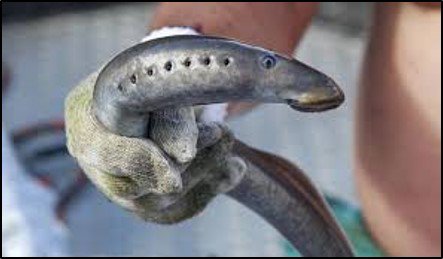Efforts to Bring Back Pacific Lamprey Succeeding
Increasing numbers are returning to Bonneville Dam
- July 20, 2022
- Carol Winkel

At the Council’s July meeting, Laurie Porter and Jon Hess from the Columbia River Inter-Tribal Fish Commission briefed members on the current run of Pacific lamprey in the Columbia River Basin and tribal projects currently implemented through the Council’s Columbia River Basin Fish and Wildlife Program.
Recent results show that adult offspring are returning in increasing numbers to Bonneville Dam as a direct result of the translocation programs implemented by the Confederated Tribes of the Umatilla Indian Reservation, Confederated Tribes and Bands of the Yakama Nation, and Nez Perce Tribe. By moving adults to suitable habitats, researchers found that overall productivity increased. These translocations are also restoring Pacific lamprey to historical areas where they had been nearly extirpated.
These recent results confirm the model predictions from a study of Snake River Pacific Lamprey translocations that was featured earlier this year in the scientific journal Transactions of the American Fisheries Society. In the published study, an increase of larval and juvenile Pacific lamprey abundance was directly linked to the translocation efforts of the tribes. Gradually, those same offspring have been rearing in streams and then migrating downstream to the mainstem Columbia River and the Pacific Ocean before reappearing as adults half a decade later at Bonneville Dam.
Pacific lamprey, prized by Northwest tribes along with salmon, are considered an important species in the Council’s Columbia River Basin Fish and Wildlife Program, which calls for actions to improve lamprey migration success, survival, and growth.
Their historic runs in the basin, once estimated to be in the millions, have decreased precipitously over the years, and they currently return in drastically smaller numbers.
As they migrate from the mouth of the Columbia River to Chief Joseph and Hells Canyon dams in the mainstem Columbia and Snake rivers, they navigate through dams with passage systems designed for salmon. Many dams with fish ladders for salmonids only pass about 50 percent of adult Pacific lamprey, and little is known about juvenile lamprey passage and their overall survival. Lamprey passage improvements such as lamprey-specific passage structures are being constructed at the mainstem dams.
Other threats to lamprey include flow alterations and dewatering; stream and floodplain degradation; degraded water quality; predation; and changing marine and climate conditions.
Currently, there are six active projects that focus on Pacific lamprey funded through the Council’s program. These projects have a variety of goals and objectives, but generally aim at establishing population status and trends; documenting distribution; identifying limiting factors; and developing reintroduction and supplementation actions.
The key conclusions from translocation programs: After five or more years in the ocean, Snake River natal-origin adults returned at Bonneville Dam—over 300 adult offspring of Snake River translocations returned to Bonneville Dam in 2021, and a total of over 1,000 adult offspring from all three tribal translocation programs returned to Bonneville Dam in 2021.
Models suggest that even more adult translocation offspring could return to Bonneville Dam by 2023. Of those Snake River origin Pacific lamprey that returned to the Columbia River, the preferred migration route is to Bonneville Dam—97 percent returned to Bonneville Dam compared to Willamette Falls.
Learn More



